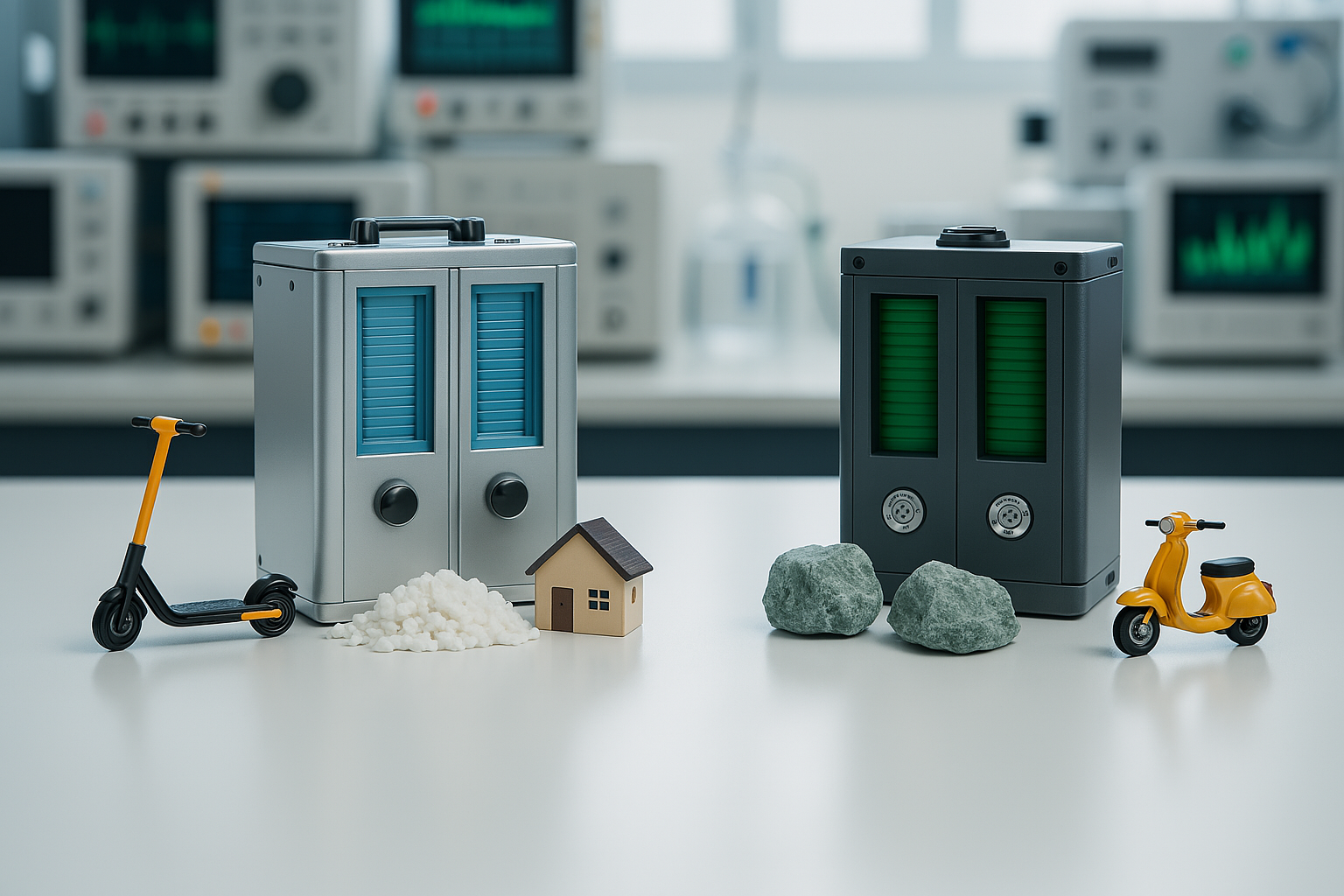Sodium-ion batteries have become an attractive alternative to traditional lithium-ion solutions. This shift makes sense since lithium prices have soared by more than 700% since 2021. The abundance of sodium, which is 500 times more available than lithium, makes these batteries an economical and environmentally responsible choice for grid storage applications. Lithium iron phosphate (LiFePO4) batteries lead the market today with their remarkable 8,000 to 10,000 cycle life. Sodium-ion technology brings unique benefits: it charges faster, offers better safety features, and reduces the risk of thermal runaway. These characteristics matter significantly for grid storage systems. The technology’s potential hasn’t gone unnoticed – over 36 companies in China now develop or produce these batteries. This piece compares sodium-ion and LiFePO4 batteries to help you choose the right option for your grid storage requirements.
Technical Specifications That Matter
Power output and cycle life are vital metrics to evaluate battery technologies for grid storage applications. Technical specifications show clear differences between sodium-ion and LiFePO4 batteries.
Power Output Capabilities
Sodium-ion batteries show remarkable power density capabilities that reach up to 1 kW/kg. These numbers exceed both nickel-manganese-cobalt (340W/kg to 420 W/kg) and LiFePO4 (175 W/kg to 425 W/kg) alternatives. Sodium-ion cells’ energy density ranges from 130 Wh/kg to 160 Wh/kg. Advanced variants now show improved energy densities between 100 Wh/kg to 170 Wh/kg and might reach 220 Wh/kg.
Temperature performance gives sodium-ion technology another edge. These batteries work well at lower temperatures and can charge at temperatures as low as -10°C. The energy efficiency changes based on the state-of-charge (SOC), and batteries perform best above 50% SOC.
Cycle Life Expectations
The cycle life comparison between these technologies presents interesting results. Commercial LiFePO4 batteries lead the pack with 8,000-10,000 cycles. Sodium-ion technology keeps advancing with newer developments. Recent breakthroughs show cycle lives ranging from 3,000 to 8,000 cycles, depending on specific models and usage conditions.
The depth of discharge (DoD) affects cycle life performance substantially. Sodium-ion batteries keep 70-80% capacity retention through their cycle life. Temperature and charging patterns affect longevity directly. Modern sodium-ion batteries use advanced electrode materials and sophisticated battery management systems to optimize performance and extend their operational lifespan.
State-of-charge management is essential for sodium-ion batteries. Energy efficiency losses below 50% SOC can double compared to operation above this threshold. These batteries also show higher resistance and impedance dependence on temperature and SOC than their LiFePO4 counterparts.
Environmental Impact Assessment
Battery technologies’ environmental footprint plays a key role in eco-friendly energy storage solutions. A full picture shows key differences between sodium-ion and LiFePO4 batteries throughout their lifecycle stages.
Raw Material Sourcing
These technologies differ greatly in their extraction process. Sodium costs 50 times less than lithium and comes from plentiful sources like sea salt. Lithium mining produces about 15 tons of CO2 for each ton of lithium extracted. The process also creates major environmental problems, leading to water shortages and ecosystem damage in mining areas.
Manufacturing Carbon Footprint
Manufacturing methods create different environmental effects. Sodium-ion batteries perform better regarding mineral availability within cradle-to-gate limits. These batteries currently create more greenhouse gas emissions during production. The carbon footprint mostly depends on the type of electricity used in manufacturing. Clean energy sources reduce emissions and help maximize sodium-ion technology’s benefits.
End-of-Life Recycling Options
Recycling shows clear differences between these technologies. Only 5% of lithium-ion batteries get recycled worldwide, and the process faces complex technical hurdles. The recycling steps include:
1. Collection and sorting in specialized containers
2. Professional disassembly and hazardous material removal
3. Material recovery through mechanical processing
4. Chemical refining for mineral purification
Sodium-ion batteries need simpler, less toxic recycling processes. New selective leaching and direct recycling methods show great promise. Recycled battery materials now create a carbon footprint four times smaller than raw materials.
The recycling industry needs better infrastructure to handle more end-of-life batteries, especially for grid storage applications. Strong recycling systems are vital since poor disposal can release toxic substances into water supplies and animal food chains. Both technologies need effective end-of-life management strategies to get the most environmental benefits and recover resources efficiently.
Integration with Existing Grid Systems
Battery energy storage systems are crucial to modernizing power grids in many ways. These systems work together with energy production, consumption, and storage components.
Compatibility Requirements
The modern grid infrastructure needs specific technical prerequisites to integrate smoothly. Battery storage systems should provide key services like frequency regulation, load balancing, and emergency reserves. Sodium-ion batteries work well with renewable energy sources and can be flexibly deployed in microgrids of all sizes up to large utility-scale installations.
The integration process needs advanced control and optimization algorithms that meet operational requirements. These systems must follow strict safety and regulatory standards to ensure reliable performance and maintain grid stability. Battery management systems now use sophisticated monitoring tools for:
– Frequency regulation and load following capabilities
– Cold-starting functionalities
– Emergency power reserves
– Peak-to-off-peak energy balance maintenance
– Localized power quality support
Installation Challenges
Grid-scale storage systems face several technical hurdles during implementation. The biggest problems are component integration complexity and supply chain vulnerabilities. Sodium-ion batteries’ quick commercialization brings up new questions about performance validation at scale.
Grid operators must review installation requirements carefully, especially thermal management systems and safety protocols. The Construction Design and Management Regulations set specific duties for asset owners, designers, and contractors.
1. Key installation factors include:
2. Fire detection and monitoring systems
3. Emergency response protocols
4. Ventilation and exhaust requirements
5. Security system implementation
6. Quality control measures
Manufacturers have announced over 240 GWh of sodium-ion cell manufacturing pipeline through 2030. This rapid scaling requires full quality assessments and strict testing protocols to ensure reliable ground application performance. Electrode research and product integrations also benefit from detailed risk and safety reviews.
Future Development Roadmap
Sodium-ion battery technology is making big strides in grid storage applications. Research teams worldwide are working to boost performance and make these batteries commercially viable.
Technology Improvements Pipeline
Today’s sodium-ion batteries deliver energy density between 130-160 Wh/kg. Next-generation cells will pack more power, likely reaching beyond 200 Wh/kg by 2025. Major manufacturers are already showing great results. CATL’s second-generation sodium battery will launch in 2024 with better performance. BYD’s latest work shows these batteries might cost the same as lithium iron phosphate ones next year.
Market Growth Predictions
The sodium-ion battery market hit GBP 252.54 million in 2023 and will grow to GBP 665.90 million by 2029. This is a big deal as it means that the market could reach GBP 3.97 billion by 2032. China dominates with 99.4% of sodium-ion cell production, but this share will drop to 90.6% by 2030.
Cost Reduction Potential
The economics make sodium-ion technology very attractive. These batteries could cost 20-30% less than lithium iron phosphate options when produced at scale. Here’s why they’re cheaper:
1. Raw Material Economics
a. Sodium is 1,000 times more common than lithium
b. Getting and purifying sodium costs less
c. No need for expensive materials like cobalt and nickel
The Department of Energy wants to cut costs by 90% for storage systems that last over 10 hours within a decade. Scientists keep working on better conductivity and stability. As production grows and technology gets better, sodium-ion batteries are becoming a strong choice for grid storage.
Conclusion
Sodium-ion batteries serve as a promising alternative to LiFePO4 technology in grid storage applications. LiFePO4 batteries lead the market with their impressive cycle life of 8,000-10,000 cycles. However, sodium-ion alternatives pack more power density and perform better in cold temperatures while offering improved safety features.
Economics make a strong case for sodium-ion technology. Sodium exists 500 times more abundantly than lithium, which keeps extraction costs low. These batteries also shine on the environmental front. They’re easier to recycle and need less mining compared to their lithium counterparts.
Economics makes a strong case for sodium-ion technology. Battery makers are ramping up their production. Their announced plans show capacity above 240 GWh through 2030. Technical advances could push energy densities past 200 Wh/kg by 2025. On a scale, material costs might drop 20-30% below LiFePO4 options.
Grid operators need reliable, budget-friendly storage options. They should think over both technologies based on their specific needs. Anyone learning about energy storage options for their grid setup can reach out to our expert team. We provide custom recommendations and help with implementation.






